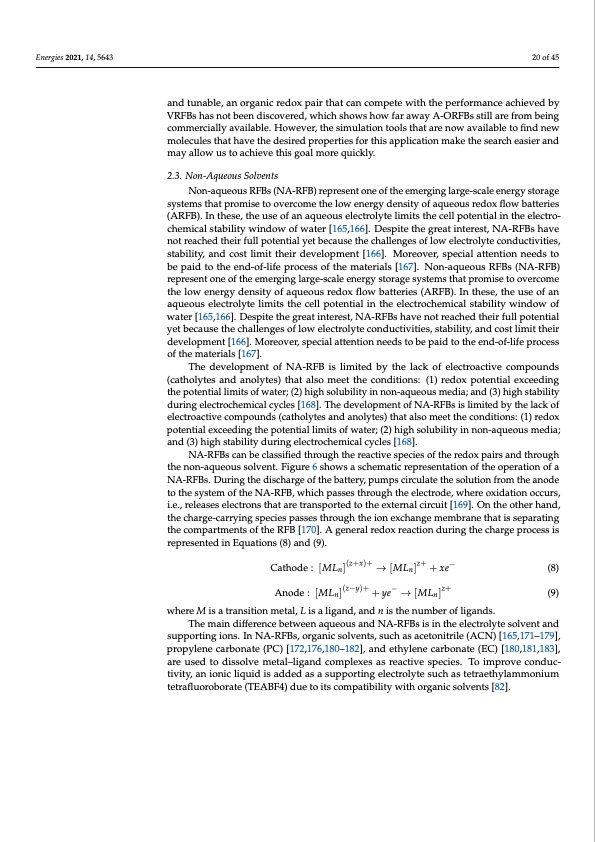
PDF Publication Title:
Text from PDF Page: 020
Energies 2021, 14, 5643 20 of 45 and tunable, an organic redox pair that can compete with the performance achieved by VRFBs has not been discovered, which shows how far away A-ORFBs still are from being commercially available. However, the simulation tools that are now available to find new molecules that have the desired properties for this application make the search easier and may allow us to achieve this goal more quickly. 2.3. Non-Aqueous Solvents Non-aqueous RFBs (NA-RFB) represent one of the emerging large-scale energy storage systems that promise to overcome the low energy density of aqueous redox flow batteries (ARFB). In these, the use of an aqueous electrolyte limits the cell potential in the electro- chemical stability window of water [165,166]. Despite the great interest, NA-RFBs have not reached their full potential yet because the challenges of low electrolyte conductivities, stability, and cost limit their development [166]. Moreover, special attention needs to be paid to the end-of-life process of the materials [167]. Non-aqueous RFBs (NA-RFB) represent one of the emerging large-scale energy storage systems that promise to overcome the low energy density of aqueous redox flow batteries (ARFB). In these, the use of an aqueous electrolyte limits the cell potential in the electrochemical stability window of water [165,166]. Despite the great interest, NA-RFBs have not reached their full potential yet because the challenges of low electrolyte conductivities, stability, and cost limit their development [166]. Moreover, special attention needs to be paid to the end-of-life process of the materials [167]. The development of NA-RFB is limited by the lack of electroactive compounds (catholytes and anolytes) that also meet the conditions: (1) redox potential exceeding the potential limits of water; (2) high solubility in non-aqueous media; and (3) high stability during electrochemical cycles [168]. The development of NA-RFBs is limited by the lack of electroactive compounds (catholytes and anolytes) that also meet the conditions: (1) redox potential exceeding the potential limits of water; (2) high solubility in non-aqueous media; and (3) high stability during electrochemical cycles [168]. NA-RFBs can be classified through the reactive species of the redox pairs and through the non-aqueous solvent. Figure 6 shows a schematic representation of the operation of a NA-RFBs. During the discharge of the battery, pumps circulate the solution from the anode to the system of the NA-RFB, which passes through the electrode, where oxidation occurs, i.e., releases electrons that are transported to the external circuit [169]. On the other hand, the charge-carrying species passes through the ion exchange membrane that is separating the compartments of the RFB [170]. A general redox reaction during the charge process is represented in Equations (8) and (9). Cathode : [MLn](z+x)+ → [MLn]z+ + xe− (8) Anode : [MLn](z−y)+ + ye− → [MLn]z+ (9) where M is a transition metal, L is a ligand, and n is the number of ligands. The main difference between aqueous and NA-RFBs is in the electrolyte solvent and supporting ions. In NA-RFBs, organic solvents, such as acetonitrile (ACN) [165,171–179], propylene carbonate (PC) [172,176,180–182], and ethylene carbonate (EC) [180,181,183], are used to dissolve metal–ligand complexes as reactive species. To improve conduc- tivity, an ionic liquid is added as a supporting electrolyte such as tetraethylammonium tetrafluoroborate (TEABF4) due to its compatibility with organic solvents [82].PDF Image | PNNL Vanadium Redox Flow Battery Stack

PDF Search Title:
PNNL Vanadium Redox Flow Battery StackOriginal File Name Searched:
energies-14-05643-v2.pdfDIY PDF Search: Google It | Yahoo | Bing
Salgenx Redox Flow Battery Technology: Salt water flow battery technology with low cost and great energy density that can be used for power storage and thermal storage. Let us de-risk your production using our license. Our aqueous flow battery is less cost than Tesla Megapack and available faster. Redox flow battery. No membrane needed like with Vanadium, or Bromine. Salgenx flow battery
| CONTACT TEL: 608-238-6001 Email: greg@salgenx.com | RSS | AMP |